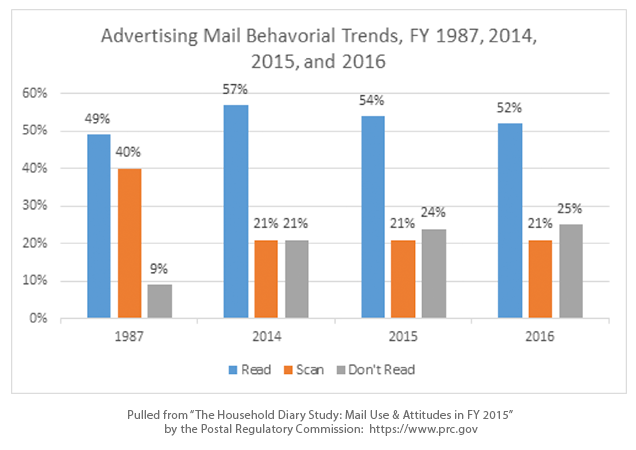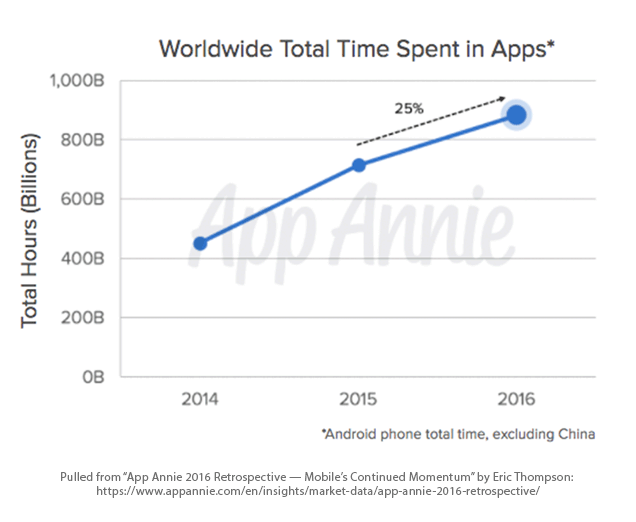What’s new in TV marketing?
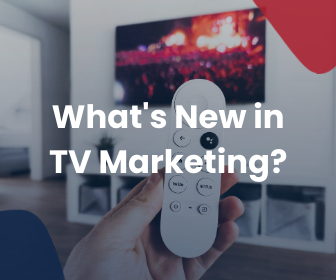
One thing that stays constant, even in the midst of challenging circumstances such as a pandemic, is that people consume media. We always seek out entertainment and information. Content consumption is at an all-time high and therefore, competition for viewer’s attention is as well. However, 84% of marketers say that it is getting harder to grab a consumer’s attention with television advertising alone. Most advertisers surveyed say that TV ads isn’t the first thing that they plan anymore, instead starting with digital and then working in TV. How can CTV and OTT change that?
CTV and OTT
Many marketers are using CTV (connected TV) or OTT (over-the-top) channels to target consumers using streaming services and connected TV devices such as Hulu and Roku. Advertises are embracing these platforms as more and more ad space becomes available. Spending for CTV advertising grew from $6.94 billion in 2019 to $8.88 billion in 2020, a 28% increase.
Advertiser spent an estimated $8.88 billion on CTV in 2020
What’s the difference between CTV and OTT? Connected TV are things like Apple TV and Amazon Firestick. It is marketing based on the devices used to connect users to TV without cable. Over the Top is advertising space found on streaming services, like hulu and Peacock. (Personally, it helps me to think of them like CTV is hardware and OTT is software.) Right now in the United States more people are reachable through CTV and OTT than with cable. Hulu alone made $3 billion in ad revenue last year!
Disadvantages?
What are some disadvantages? There is one main thing. CTV and OTT have lower engagement rates than people who come from digital advertising expect. Why? Well, theres no way to click or show engagement through your TV. For the consumer to follow through a call-to-action, they probably are going to use a different device. Cross device traffic is harder to push and harder to track.
With old school TV advertising, an ad’s effectiveness was tracked by seeing if sales went up in the area the ad played. Thats just not enough data now, especially if CTV/OTT is just a piece of a multichannel campaign. It’s important to be able to track every part of a campaign.
Tracking Options
Option 1: Use IPs. Most people make big purchases on their home wifi. Using retargeting and IP based cookies, it’s pretty simple to serve ads across devices.
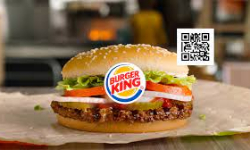
Option 2: Use, specific trackable call-to-actions. Building in gamification to CTV/OTT ads allows consumers to use their phones to follow the call-to-action. The QR-code Burger King ad is a fantastic example of this. In a CTV ad, Burger King challenged consumers to “catch” a moving QR code. If you caught the QR code, it took you to download their app and with the app download, they gave you a free Whopper. It was fun and engaging AND trackable.
Into the Future
Since CTV/OTT is a relatively new ad format, theres a lot new and exciting ways it can be used in the future!
- New ad formats.
We will probably see more direct response ads like the Burger King one. As well as things like pause ads. Ads the are promoted when a users pauses the program. A great way some companies are starting to use this is thinking about why someone would need to pause the show. Are they hungry? How about an Uber Eats ads? Or do they need a bathroom break? Maybe a toilet paper ad?
Another new ad format is contextual-in-show advertising. A billboard in the background of a show can be sold as ad space. It can be changed based on who is watching the show. - Programmatic Linear TV is also starting to become more of an option. Although quite new, it’s becoming more possible to use Nielsen-based user-level data (age, demographic, income) or media-level targeting (show, part of day, network) to inform programmatic style ad spend for traditional linear TV. 20% of advertisers surveyed said that they planned to incorporate programmatic linear into their marketing plans this year, and another 20% said that while they aren’t incorporating it this year, they plan to in the near future.

How will TV advertising change in the future? It’s possible that as CTV and OTT take over the traditional TV space household level targeting such as IP address and Neilson style demographics will become the identification of choice for marketers looking to incorporate TV into their omnichannel campaigns.
Using new tools and integrating in traditional ones, marketers will be able to effectively use TV in their campaigns on into the future!
The Value of the Social Proof Phenomenon
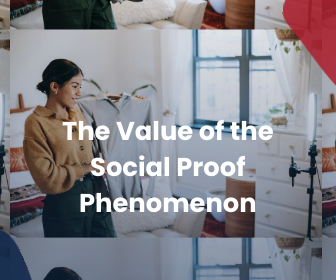
The Social Proof Phenomenon is a foundation piece of how our culture buys now. Between Instagram Influencers, Yelp reviews, and 5 star Amazon products, most of us make purchase decisions on the value others see in the product. How can Social Proof and online reviews work for you?
The Social Proof Phenomenon
What do online reviews have to do with “Social Proof?” “Social Proof” is the phenomenon based on the fact that it’s easier to buy things or trust companies if we know that other people already have. Our peers provide the proof of something’s value. None of us would buy something on Amazon with 10,000 1 star reviews. We trust those 10,000 strangers because that product connects us as a community.
“Social proof” is also part of the transparency that builds brand trust. Most consumers (almost 88%) research a business before buying from them. A lot of that research comes from reviews and reading what other people have said about their experiences.
What Can Social Proof Do For You?
Reviews can help educate consumers on your products and services. Reviewers usually talk about their specific experiences in their reviews. It can be an easier way for potential customers to learn more about what you offer.
Reviews Boost SEO. Specifically, Google Reviews. Google indexes reviews connected to your listing to help filter results. Especially for local traffic. “Best __ Near Me” is decided by reviews and stars. Customers will often use your keywords in reviews without even realizing it. This helps Google learn about you.
What Can You Do To Collect Reviews?
People are inclined to leave reviews if they a specifically positive or negative experience. Therefore, work hard to provide an overwhelmingly positive expertise for your customers! (You should be doing this anyway; the review is just a byproduct. 😉 )
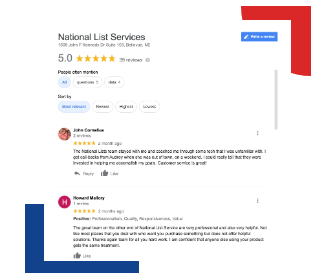
People like to do things for other people so a great way to collect reviews is to just ask for them! A follow up survey email after they buy from you is an easy way to this. Ask them specific, easy to answer questions about things such as: service response times, shipping times, product or service quality etc.
Make it easy to review you. No one has time to take 10 minuets following a complicated review survey with long required written answers. People are doing you a favor by reviewing you, show that you appreciate it by being respectful of their time and effort. Take out pain points of the review process: go through and make sure there aren’t any unnecessary steps or questions. Double check the user interface, id it easy to figure out?
Incentivizing your reviews (specifically ecommerce) is a big no-no! As temping as it is to show your appreciation for the review with a coupon or free shipping, or something: don’t. Both Google and Yelp have policies in place banning incentivized reviews. They will take the reviews down and give you a slap on the wrist.
What To Do With Reviews Once You Have Them
You have the reviews – now what? Here’s 2 ways to leverage them!
- Show them off
Let your reviews sell your product for you. Happy previous customers can be a great way to convince your potentials to buy from you! Show off your reviews on your home page with Google review widget or prominently feature some reviews as part of the design. Don’t forget to ask for permission first if you are going to highlight a specific review, especially if you are going to use their picture. - Engage with reviewers
let them know you appreciate them! It doesn’t have to be a big deal, simply liking the review or just saying thanks goes a long way. That little bit of effort can turn a happy customer into a loyal one. And a lot of marketing automation software makes replying to reviews across multiple platforms easy.
Do you have a favorite customer review?
While we are on the subject… leave us a review! 😜
How do these marketing channels stack up?
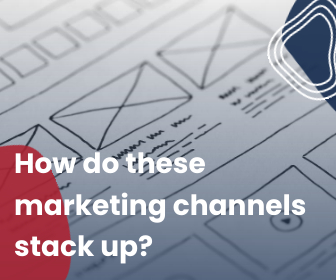
There are A LOT of different marketing channels out there. What are the pros and cons of some of the common ones?
Social Media
Pro
There are over 3.8 billion people on social media around the world. Social media is a fantastic way to connect with customers, build brand loyalty, and generate sales.
People don’t just want to buy from companies because they have good products and services. They want to know what your brand stands for in addition to what it sells. Social media can help potential customers get to you. Social media feel like a 1-on-1 conversation between the brand and consumer, which helps build loyalty.
Con
A lot of the value from social doesn’t show up immediately. It’s rarely simple to track social media’s ROI. Often the goal of social media is not just to generate sales but instead to build connections. Without measurable results, using social media can be discouraging.

Pro
Often it a brand’s only way to communicate with customers and can feel very one on one. A lot of millennial and gen z’ers expect to communicate with brands through email. Also, pretty much everyone has email so you know you will be able to communicate with people through email.
Con
We all get so. many. emails. Most office workers receive 127 every day. It can be hard to stand out from the crowd. People don’t have time to read emails that don’t actually provide them value.
Email marketing also has a lot of laws and rules connected to it that can hurt you if your aren’t careful!
Content/SEO

Pro
Customers often rely on a business’s website for information. Especially for local businesses, it can be the only way to know a shop hours or address. Putting the information on a website instead of a social media or directly in a browser legitimizes the information.
Good SEO gives your website credibility. It makes it easier for people to find your website when they search for it. And it helps create a smoother user experience.
Con
Bad SEO can hurt you. Most searchers never go past the first or second page of Google, though, which is why those top spots in the search results are so coveted. Having the proper SEO can prevent your website form getting organic traffic.
53% of all trackable website traffic comes from organic search. SEO is the main thing influencing how easy it is to find you online organically. Which is probably why it’s estimated that agencies and brands spent over $79.27 Billion on SEO services last year.
Google Ads

Pro
Where are people? On their phones. So, google ads is an extremely effective way to find people where they are. Google ads is great for brand awarness as well as retargeting. It is great if you want measurable results and analytics.
Con
Billboards, signs, posters, newspapers, and magazines all exist with in different physical spaces. With digital advertising however, we are all competing for the same ad space. That ad space is worth more now has less guarantees attached to it.
Trying to figure Google ads can feel like rocket science. There’s a large learning curve and it can a while to feel confident in the set up.
Print and Mail

Pro
Direct mail average open rate is somewhere between 68 and 90%, which is double, triple, or quadruple the average open rates of other marketing channels. Do people who open direct mail actually purchase? Yes! On average people who receive direct mail purchase 28% more items and spend 28% more money!
Why is direct mail so effective? It comes down to fact that we (humans) like getting mail. 41% of Americans of all ages look forward to getting their mail every day. We still want very real things in our hands, which is something totally lost in email inboxes or on social media. That tactile connection translates into 💰.
Con
Since Direct mail requires use of the postal system it has fixed costs. The graphic design of the mail piece may also have an additional cost. Using direct always requires a bit of math and if done wrong can hurt your ROI.
It’s not always posable to see direct, measurable results, from Direct mail campaigns. And if you can measure results, it may take a while to get the full picture.
Another thing that can be a disadvantage to direct mail is that you need a really good foundation of address data. The problem us that a lot of data providers don’t make sure that their data is accurate and that hurts the effectiveness of your campaign.
Connected TV

Pro
TV is a time-tested advertising channel. Although it’s a lot less common than it used to be, it can still be very effective. Many marketers are using CTV (connected TV) or OTT (over-the-top) channels to target consumers using streaming services and connected TV devices such as Hulu and Roku. Advertises are embracing these platforms as more and more ad space becomes available. Spending for CTV advertising is expected to grow from $6.94 billion in 2019 to $8.88 billion in 2020, a 28% increase.
Con
With customer attention spread so thin and cable tv subscriptions consistently falling, (over 16 million in the last five years) there’s a lot less advertising space available. Content consumption is at an all-time high and therefore, competition for viewer’s attention is as well. 84% of marketers say that it is getting harder to grab a consumer’s attention with television advertising alone.
Audiences today expect personalized and relevant targeted ads. Linear TV (cable and network television) often fall far behind in targeting capabilities. Therefore, it can be a challenge for advertisers to figure out how to integrate linear TV into their campaigns.
A DOOH Overview
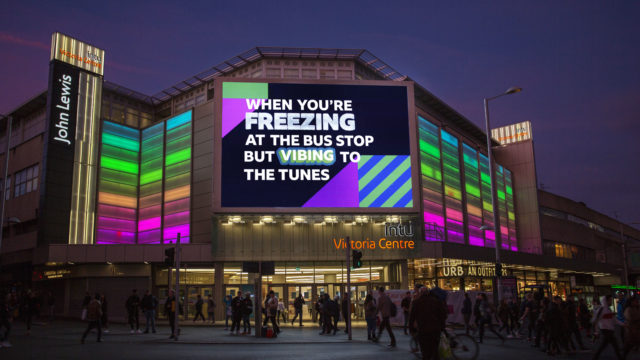
Digital Out-Of-Home (DOOH) is a return to old school advertising, combining the classic advertising experience with new technology and programmatic ad delivery. DOOH isn’t just roadside billboards anymore, digital advertisements can found just about anywhere now: elevators, gyms, airports, public transport, office buildings etc. Why is DOOH so popular?
According to MediaPost, DOOH is likely to become a more than $26 billion industry by 2023. Why? DOOH allows marketers to tailor their advertising to location, time of day, weather and traffic conditions, and more, making its reach and engagement highly effective.
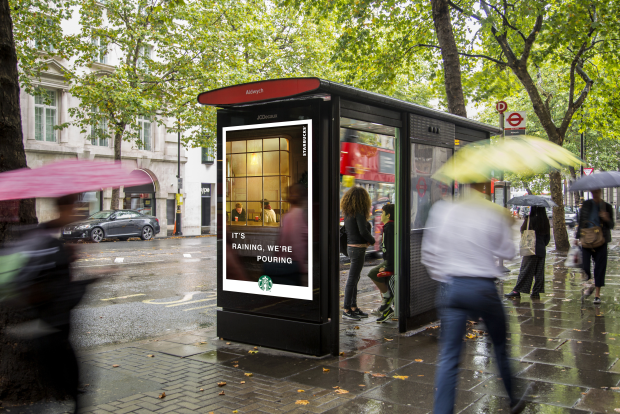
DOOH can be split into two main categories: large-format displays and digital place-based media. Large format displays are properly the main thing people think of when it comes to Digital display advertising. These displays are generally large format screens in high traffic areas such as highways and subways.
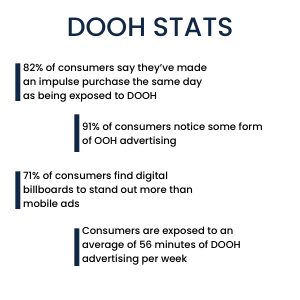
Digital place-based media are display screens located in “destinations.” These destinations are places that people are going to for a specific reason instead of just passing by.
What are the advantages of DOOH verses traditional out-of-home displays? DOOH allows marketers to update their messaging remotely and in real time. It also allows marketers to pick times of day and other factors when deciding when to show their ad.
Curious to know more about DOOH? Get in touch!
What’s Your Customer Journey?

In 2020 we have lost many personal or face to face connections with customers. Therefore, digital marketing has to feel more personal. How? Focusing on your customer’s journey is the first step.
What is a customer journey? The customer journey is the order of all of your customers interactions and experiences with your company and brand. It is often illustrated in map form.
How can you build a customer journey?
Step one, who are your current customers? Analyze your first party data. What does your average customer “look” like? What is their age, gender, occupation? Do they have any specific interests or hobbies?
Step two, who are your potentials? Once you know who your average customer is you can build a look-a-like report to gain more prospects. (What is a look-a-like report? Get more information here.)
Step three, map their journey. How do they first hear about your brand? What are going to be their first interactions? What happens before they buy something? What happens after?
Here’s how that could be illustrated:
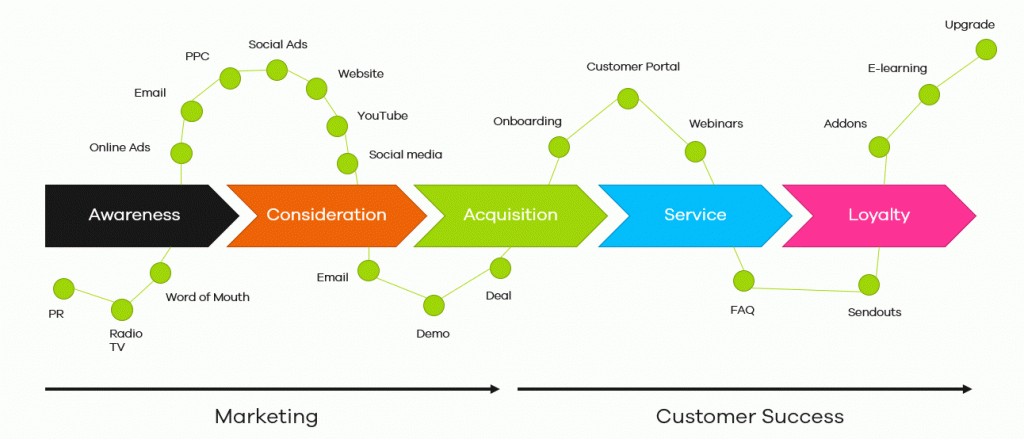
Blast marketing campaigns aren’t nearly as effective as they used to be. Building a campaign based on your customer’s journey can greatly increase your conversions and long-time customer loyalty. (One study found conversions were boosted over 300%!)
How can you use customer journeys?
6 Tips for Effective Content Marketing

According to HubSpot, nearly 70% of business are investing in upping their content production this year. What can you do to make sure your content stands out from the rest?
Here are six steps:
- Figure out what you want to accomplish. Goals are key to any plan. The Content Marketing Institute (CMI) suggests outlining your goals in a formal business plan. It will also be helpful to outline what value you are going to provide your customers with your content and any possible challenges.
- Figure out your audience. Knowing who you want to reach makes it much easier to know what type of content they’ll want to engage with.
- Remember your own branding. What do you want your customers to know about you? What problems can you solve for them? How are you different from your competitors? Knowing what your overarching message will help you choose the right type content and tone.
- Figure out what type of content your audience will respond to. There are so many different types of content, such as blog posts, eBooks, videos, podcasts, webinars, newsletters, etc. However, not all of them will be effective for your audience.
- Keep a schedule. You’ll need a clear plan of attack, especially if different parts of your organization will be involved in content. HubSpot recommends implementing an editorial and a social media calendar. To keep tract of when are where content is going out. Doing so will also help keep your messaging cohesive.
- Keep track of engagement. Keeping track of analytics will help you learn your content’s effectiveness. You can use what you’ve learned about what works or your audience to inform upcoming decisions and make your content continually more effective.
Want more information on how to make your content marketing more effective? Get in touch here.
What is it about digital marketing that chaps our hide?

My colleagues and I are in the marketing business, so when we are browsing the web, we understand the marketing and advertising we encounter. We know how it was created, and how it gets delivered to us on our screens and in our searches. But, at the end of the day—well all day actually—we are consumers just like you, and sometimes the pervasiveness and invasiveness of these ads are at a minimum annoying, and sometimes a bit anger-inducing.
So much so, that some of us do everything we can to block them by installing ad-blocker extensions to our browsers, and turning on every privacy and security options we have on our phones. Sometimes, we just defiantly refuse to even glance at them.
Although embracing these anti-ad measures offer us brief reprieve, doing so hides us from the goods and services that we need or want to know about. We essentially disconnect ourselves from the businesses and providers that we have good relationships with. Let’s simply define the issue as a communication strain between provider and consumer—a continual and dynamic struggle for comfortable digital conversation.
There are as many solutions to the struggle as there are providers and consumers. We all have a threshold of comfort that is unique to us as individuals.
Tell us what chaps your hide! We’ll continue to find zones of comfortable digital conversation so providers and consumers can stay connected.
Direct Mail is Still an Essential Part of any Marketing Strategy
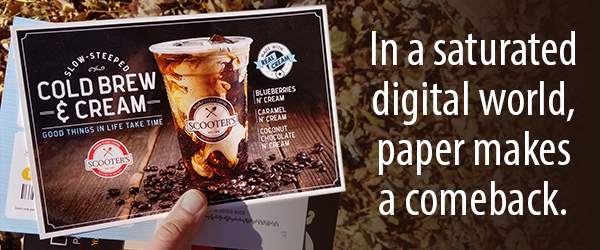 It would be easy to disregard the power of printed materials in a world on the verge of complete digitization. In terms of acting like consumers, there has been an obvious shift to the speed, efficiency and ultimate accessibility to our favorite products, brands and services via the Internet.
It would be easy to disregard the power of printed materials in a world on the verge of complete digitization. In terms of acting like consumers, there has been an obvious shift to the speed, efficiency and ultimate accessibility to our favorite products, brands and services via the Internet.
In fact, any modern marketing strategy is almost obligated to allocate a significant amount of resources to digital efforts: designing a sleek, user-friendly website, devising email campaigns and pushing social media to increase overall presence.
The immense proliferation of technology in the last few years would suggest that any need for a printed, direct mail strategy has been negated. However, in the pursuit of high-performance marketing, this is still a hugely valuable asset that when combined with powerful big-data insights, can bolster your overall strategy and ultimately boost sales.
Print’s dead, though, right?
Not only is direct mail still a viable marketing tactic, it could actually provide your company with an opportunity to stand out amidst all of the competition we now find online. While it shouldn’t be your company’s sole tool, it can act in a complementary role in terms of accessing your customers at the right time with a relevant message. While digitization has forced the newspaper and magazine industries to downsize and adapt, companies are still finding benefits from mailing their customers directly.
Why? For several reasons. First of all, it can be your company’s personal touch.
Mobile data is giving marketers better insights into what consumers are searching for, what they’re trying to purchase and when. This is critical in terms of designing targeted approaches to ensure consumers are actually benefiting from your marketing. However, it’s easy to lose any kind of personalization when everything is automated. With more complete and accurate mailing lists–informed by big-data–direct mail is still the standard for reaching out to customers with a personal touch.
 We still want very real things in our hands, which is something totally lost in email inboxes.
We still want very real things in our hands, which is something totally lost in email inboxes.
The flexibility of direct mail allows you to create something that can reach into consumer psyches more deeply than well-crafted emails. Something that is attention grabbing, boosted by rich visuals (as opposed to lengthy text on a screen), with a simple progression that directs the customer to follow your desired call to action, can propel consumers to either act or at least take notice.
Keys for an effective direct mailing strategy, in terms of the actual materials being sent (according to the Data & Marketing Association):
Be bold.
We have short attention spans. Marketing that cuts through the clutter with attention-getting graphics and copy more apt to gain and hold that attention.
Visuals rule.
In fact, the brain processes visuals exponentially faster than the time it takes the brain to decode text. Well used imagery can quickly get your piece noticed, and your message across.
Keep it simple.
Direct mail that creates a simple decision path with limited copy and explanation always tests better.
Furthermore, in an industry that finds immense value in data, direct mail can be directly measurable.
The United States Postal Service is an integral part of our country’s overall mailing industry. In fact, because it can deliver mail to every address (Every Door Direct Mail), companies like UPS and FedEx often piggyback off of its services. This is important because the USPS is able to constantly measure how much mail is coming and going, what kind of mail is being sent, and even whether or not people are reading their mail.
The United States Postal Service almost does the work for marketing researchers.
A large part of this is accomplished by the Household Diary Study (HDS), a survey that’s been conducted by the USPS since 1987. The metrics from this survey can provide insight to companies trying to make the most of their direct mail efforts. These metrics include total mail sent and received by households based on different demographics ranging from the age and size of households, education and income levels, and access to the Internet. According to this survey, in 2016 advertising mail represented 62 percent of all mail sent and received by households (about 79 billion pieces of mail). The culmination of this data, paired with the insights of mobile and big-data , make it possible for your company to appropriately and accurately determine how best to approach consumers.
Advertising Mail Received by Income and Education (Pieces per Household per Week)
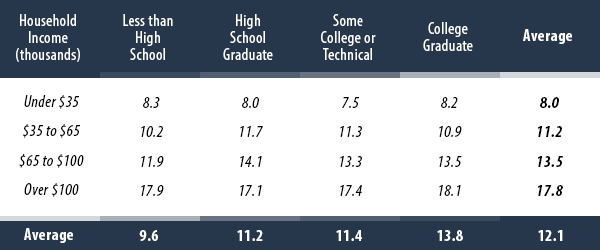
Advertising Mail Received by Income and Age (Pieces per Household per Week)
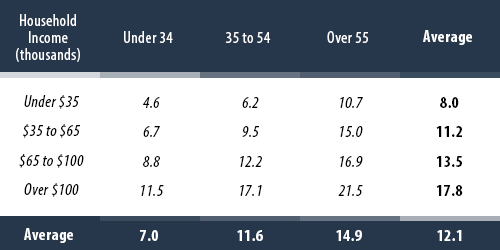
“73 percent of households either read or scan advertising mail received”
Ok, but what about the cost?
In terms of how cost-effective direct mail can be, it depends on how you decide to approach it. It can be expensive, especially if you’re sending out large catalogs chalk full of visuals and designs that require professional work such as copywriters, photographers, designers and printers. Opting for First Class mail (which means reaching your customers faster) can also bump the price up, but because of how flexible direct mail can be in general, it’s a cost-effective strategy that can be tailor made to fit any budget.
Contact us to learn more about how Direct Mail marketing can boost your prospecting.
| Click here to learn more |
The Shocking Truth About Your Marketing Channel
 Many people still believe you only need one marketing channel – and they couldn’t be more wrong. For example, malls are lined with countless businesses. And most of these shops rely solely on one thing: a crowded mall area to bring people inside to buy.
Many people still believe you only need one marketing channel – and they couldn’t be more wrong. For example, malls are lined with countless businesses. And most of these shops rely solely on one thing: a crowded mall area to bring people inside to buy.
Analyst Jan Kniffen says one-third of all the big malls in America will close their doors over the next few years. Nearly two-thirds of the remaining malls will struggle.
Industry veteran John Hazen asked his peers at a recent conference: “Is anyone not seeing large traffic declines?”
Why Single Channel Marketing Is Killing You
Consider this scenario: Brandon McDonald, of Nashville, Tennessee, walks into a local store. Brandon is excited about the Nikon digital camera he’s planning to buy and have in his hands today. Yet when he gets into the store, he decides to scan and check the price with an app on his phone. An online company is selling the same camera for less than what the store is now offering. Brandon decides to buy online and wait for his camera to arrive.
Why Selling Online Doesn’t Fix This Problem Either
Remember, Brandon first wanted to buy from the local store. Like so many customers, he loves to hold the camera in his hands–instant gratification. If only the store knew what Brandon wanted. It would have been win-win for Brandon and the store.
This problem doesn’t just plague retail stores and physical products.
The Secret To One Bank’s Success
One regional bank depended almost entirely on people walking into the bank and asking for a loan.
Yes, they have a website. But only about 1% of web visitors were submitting a loan request. The bank decided to look at data for their mobile and online visitors–surprise! They could recover the business of a significant number of people who abandoned the bank’s online loan form. Sales of current-account and personal loan products shot up 25%.
This is just one way that mobile insights are changing the face of marketing. And moving the whole world toward multi- and omnichannel marketing.
![]() Your Customers Expect Multi & Omnichannel Marketing
Your Customers Expect Multi & Omnichannel Marketing
As you can see, marketing to people through multiple channels or methods increases your ability to sell and profit. Omnichannel marketing means tying these methods or channels (apps, digital tools or shopping venues) together in an easy-to-use, consistent way for even more profit. More and more, customers are expecting this kind of buying experience. They want to hop on their phone or device and see exactly what inventory you have available. Or they want to shop online and pick products up at your local store.
The Numbers Don’t Lie
Rice University studied 46,000 shoppers for a 14-month period.
Only 7% shopped online exclusively. And 20% visited stores without using any other apps or venues. A whopping 73% used multiple channels in their shopping journey. These multi/omnichannel shoppers absolutely love touchpoints – in all sorts of combinations and locations. Touchpoints like offers to compare prices and download coupons.
In fact, they are avid users of all sorts of mobile tools such as interactive catalogs and price checkers. They bought online and picked up at the store. They bought at the store and got their products shipped.
Multi-channel and Omnichannel Shoppers Are More Valuable
And those who used multiple channels spent 4% more in the store and 10% more online than the single-channel folks. In fact, those who used 4 or more channels spent 9% more in-store than the one-channel shoppers. And those who used apps to research online first? They spent 13% more in-store. Six months after these shoppers had their first omnichannel experience, they were shopping 23% more. And they were far more likely to recommend their chosen brand to friends and family.
The “Killer App”
No wonder many are calling omnichannel marketing the “killer app” – because it’s saving the future of so many businesses. Despite the bleak future of single-channel businesses, you now know the secret that empowers you to reach your customers at the right time, with the right message. It’s why the most successful marketing campaigns today are omnichannel campaigns. It’s how you give your customers what they really want.
How will you use omnichannel marketing?
Contact us to learn more about how multi-channel & omnichannel marketing can improve your prospect marketing.
| Click here to learn more |
The Power of Mobile Data in a Data-Centric World

Modern marketing is fully embracing the explosive emergence of mobile-based consumer data. Because of its ability to capture a more accurate snapshot of when consumers are seeking out a particular company–or its products and services–mobile data has created a step-change in how marketers are crafting and delivering their message. Consumers are seeing this change manifest itself into today’s highest performing omnichannel strategies; which is connecting them with the right message, through the right channel, and most critically… at the right time.
It’s estimated that by 2020 more than 80 percent of adults worldwide will have mobile devices. This is going to continue to drive up social media usage, increased families with multiple devices, and even more data for marketers to utilize to better connect with consumers. Smartphones and tablets have given consumers real strength in terms of providing them with multiple platforms to access businesses, for finding information on products and services, and to even purchase those items.
What Do the Numbers Say?
How much data the world currently uses is creeping up, rising from 7 exabytes per month in 2016 to 11 exabytes per month in 2017, with a predicted increase to 17 exabytes per month in 2018 (one exabyte is one quintillion bytes). However, that number could increase exponentially to 49 exabytes per month in 2021.
According to a survey developed by App Annie, worldwide app downloads in 2016 exceeded 90 billion (an increase of more than 13 billion). During this time, the number of hours that consumers spent using these apps boomed by more than 150 billion hours to almost 900 billion hours. While this will add an incredible amount of data for marketers to sift through, it will also lead to more accurate, relevant marketing lists that will allow businesses to reach out and connect with consumers at the right time, in the right way.
“Increasing the quality of sales leads, improving the quality of sales lead data, improving prospecting list accuracy, territory planning, win rates and decision maker engagement strategies are all areas where big data is making a contribution to sales today.” said Forbes’ Contributor Louis Columbus.
What Does This Mean For Marketers?
What this information will allow marketers to do is to gain better insight into when, where, and how consumers are spending money. It also empowers businesses with the means to evaluate the performance of their product and services in the market; such as determining pricing and placement.
The number of devices consumers have access to is increasing; the number of apps being downloaded and the time spent on them is increasing; and marketing dollars used in the mobile space are increasing; all because of how quickly consumers are incorporating new technology into their lives. Generation Z is being raised with devices in their hands while millennials perpetually push technology and app trends (such as boosting Instagram, Facebook, Twitter to new heights). It has become obvious that with such an integration of technology into our daily lives, marketers are going to be inundated with information about its consumers from across multiple channels in order to connect with them with relevant and timely offers.
The Emergence of Life Event Marketing
It has become apparent that the insights from mobile data can provide businesses with opportunities for identifying when consumers are experiencing a significant life event. If a particular consumer has entered into a fairly monumental life phase (which usually involves large, complex purchases) chances are they’re using several apps or platforms to access the products and services associated with these events. This is valuable information for marketers, which is reflected in a study conducted by Royal Mail Data Services. In 2014, only 15 percent of marketers surveyed saw life events as a new sales opportunity, 32 percent surveyed said those events provided a reason to engage with customers. In just a year, those numbers jumped to 50 percent and 70 percent, respectively, indicating how marketers were viewing these particular moments to connect with consumers.
Contact us to learn more about how mobile insights can improve your marketing.
| Click here to learn more |

